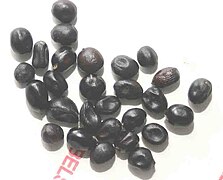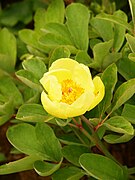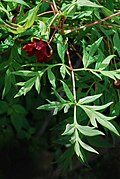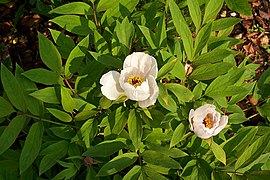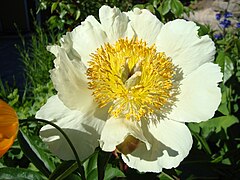Peony
| Peony | |
|---|---|

| |
Paeonia suffruticosa
| |
| Scientific classification | |
| Kingdom: | Plantae |
| Clade: | Tracheophytes |
| Clade: | Angiosperms |
| Clade: | Eudicots |
| Order: | Saxifragales |
| Family: | Paeoniaceae Raf.[1] |
| Genus: | Paeonia L. |
| Type species | |
| Paeonia officinalis L.
| |
| Sections | |
and for lower taxa see text | |
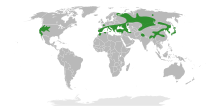
| |
| The range of Paeonia. | |
The peony or paeony (/ˈpiːəni/)[2][3] is a flowering plant in the genus Paeonia,[4] the only genus in the family Paeoniaceae. Peonies are native to Asia, Europe, and Western North America. Scientists differ on the number of species that can be distinguished, ranging from 25 to 40,[5][6] although the current consensus describes 33 known species.[7] The relationships between the species need to be further clarified.[8]
Most are
Peonies are popular garden plants in temperate regions. Herbaceous peonies are also sold as cut flowers on a large scale, although generally only available in late spring and early summer.[9]
Description
Morphology
All Paeoniaceae are
-
Paeonia suffruticosa,
Spring buds -
P. ludlowii Spring shoot
-
young growth of
a tree peony -
Paeonia veitchii,
leaf -
Paeonia tenuifolia,
leaves and flower buds -
Paeonia suffruticosa, showing the disk that encloses the carpels
-
Paeonia wittmanniana,
ripe follicles with seeds -
Paeonia anomala,
seeds
Phytochemistry
Over 262 compounds have been obtained so far from the plants of Paeoniaceae. These include
Paeoniaceae are dependent on
Genome
The basic chromosome number is five. About half of the species of the section Paeonia however is tetraploid (4n=20), particularly many of those in the Mediterranean region. Both allotetraploids and autotetraploids are known, and some diploid species are also of hybrid origin.[10]
Taxonomy
The family name "Paeoniaceae" was first used by Friedrich K.L. Rudolphi in 1830, following a suggestion by
The remainder of the species belongs to the section Paeonia, which is characterised by a complicated
Phylogeny
Recent genetic analyses relate the monogeneric family Paeoniaceae to a group of families with woody species in the order Saxifragales. This results in the following relationship tree.[16] One dissertation suggests the section Onaepia branches off earliest, but a later publication of the same author and others suggests the Moutan-section splits off first. Within that section P. ludlowii and P. delavayi are more related to each other than to any other species.[19][20]
|
|
|---|
Species
- Herbaceous species (about 30 species)
- Paeonia algeriensis
- Paeonia anomala
- Paeonia turcica
- Paeonia arietina
- Paeonia broteri
- Paeonia brownii (Brown's peony)
- Paeonia californica (California peony or wild peony)
- Paeonia cambessedesii (Majorcan peony)
- Paeonia clusii
- subsp. clusii
- subsp. rhodia
- Paeonia coriacea
- Paeonia corsica
- Paeonia daurica
- subsp. coriifolia
- subsp. daurica
- subsp. macrophylla
- subsp. mlokosewitschii
- subsp. tomentosa
- subsp. velebitensis
- subsp. wittmanniana
- Paeonia emodi
- Paeonia intermedia
- Paeonia kesrouanensis (Keserwan peony)
- Paeonia lactiflora (Chinese or common garden peony)
- Paeonia mairei
- Balkan, wild or male peony)
- subsp. mascula
- subsp. bodurii
- subsp. hellenica
- subsp. russoi
- Paeonia obovata
- subsp. willmottiae
- Paeonia officinalis (European or common peony, type species)
- Paeonia parnassica (Greek peony)
- Paeonia peregrina (Kosovo or Romanian peony)
- Paeonia sterniana
- Paeonia tenuifolia (Steppe peony)
- Paeonia veitchii (Veitch's peony)
- Woody species (about 8 species)
- Paeonia decomposita
- Paeonia delavayi (Delavay's tree peony)
- Paeonia jishanensis (Jishan peony)
- Paeonia ludlowii (Ludlow's tree peony)
- Paeonia ostii (Osti's peony)
- Paeonia qiui (Qiu's peony)
- Paeonia suffruticosasubsp. rockii (Chinese tree peony, known as "moutan (moutan peony)" in China))
-
Paeonia anomala
-
Paeonia broteri
-
Paeonia brownii
-
Paeonia californica
-
Paeonia cambessedesii
-
Paeonia cambessedesii
-
Paeonia daurica subsp. mlokosewitschii
-
Paeonia delavayi
-
Paeonia emodi
-
Paeonia intermedia
-
Paeonia ludlowii
-
Paeonia mairei
-
Paeonia mascula
-
Paeonia mascula subsp. russoi
-
Paeonia peregrina
-
Paeonia obovata subsp. japonica
-
Paeonia officinalis
-
Paeonia ostii
-
Paeonia rockii
-
Paeonia tenuifolia
Distribution
The genus Paeonia naturally occurs in the temperate and cold areas of the Northern Hemisphere. The section Moutan, which includes all woody species, is restricted in the wild to Central and Southern China, including Tibet. The section Onaepia consist of two herbaceous species and is present in the West of North-America, P. brownii between southern British Columbia and the Sierra Nevada in California and eastward to Wyoming and Utah, while P. californica is limited to the coastal mountains of Southern and Central California.
The section Paeonia, which comprises all other herbaceous species, occurs in a band stretching roughly from Morocco and Spain to Japan.
One species of the section Paeonia,
The species around the Mediterranean include
Between the two concentrations, the subspecies of Paeonia daurica occur, with subspecies velebitensis in Croatia, and daurica in the Balkans and Crimea, while the other subspecies coriifolia, macrophylla, mlokosewitschii, tomentosa and wittmanniana are known from the Caucasus, Kaçkar and Alborz Mountains.
Paeonia emodi occurs in the western Himalayas between Pakistan and western Nepal, P. sterniana is an endemic of southeastern Tibet, P. veitchii grows in Central China (Qinghai, Ningxia, Gansu, Shaanxi, Shanxi, Sichuan and the eastern rim of Tibet), like P. mairei (Gansu, Guizhou, Hubei, Shaanxi, Sichuan, and Yunnan), while P. obovata grows in warm-temperate to cold China, including Manchuria, Korea, Japan, Far Eastern Russia (Primorsky Krai) and on Sakhalin, and P. lactiflora occurs in Northern China, including Manchuria, Japan, Korea, Mongolia, Russia (Far East and Siberia).[18]
Distributional history
The species of the section Paeonia have a
Cultivation

Ancient Chinese texts mention the peony was used for flavoring food. Peonies have been used and cultivated in China since early history. Ornamental cultivars were created from plants cultivated for medicine in China as of the sixth and seventh century. Peonies became particularly popular during the Tang dynasty, when they were grown in the imperial gardens. In the tenth century the cultivation of peonies spread through China, and the seat of the Song dynasty, Luoyang, was the centre for its cultivation, a position it still holds today.
A second centre for peony cultivation developed during the
Plant growth habits
While the peony takes several years to re-establish itself when moved, it blooms annually for decades once it has done so.[22]
Peonies tend to attract ants to the flower buds. This is due to the nectar that forms on the outside of the flower buds, and is not required for the plants' own pollination or other growth.[23] The presence of ants is thought to provide some deterrence to other harmful insects though, so the production of ant-attracting nectar is plausibly a functional adaptation. Ants do not harm the plants.[24]
Peony species come in two distinct growth habits, while hybrid cultivars in addition may occupy an intermediate habit.
- herbaceous: During summer, renewal buds develop on the underground stem (the "crown"), particularly at the foot of the current season's annual shoots. These renewal buds come in various sizes. Large buds will grow into stems the following growing season, but smaller buds remain dormant. The primordia for the leaves can already be found in June, but the flower only starts differentiating in October, as the annual shoots die down, completing its development in December, when sepals, petals, stamens and pistils are all recognisable.[9]
- tree: During the summer, large buds develop at the tip of the annual growth and near its foot. In the autumn, the leaves are shed, and the new stems become woody and are perennial.
- Itoh (or "Intersectional"): In 1948 horticulturist Toichi Itoh from Tokyo used pollen from the yellow tree peony "Alice Harding" to fertilize the herbaceous P. lactiflora "Katoden", which resulted in a new category of peonies, the Itoh or intersectional cultivars. These are herbaceous, have leaves like tree peonies, with many large flowers from late spring to early autumn, and good peony wilt resistance. Some of the early Itoh cultivars are "Yellow Crown", "Yellow Dream", "Yellow Emperor" and "Yellow Heaven".[25]
Flower types
Seven types of flower are generally distinguished in cultivars of herbaceous peonies.
- single: a single or double row of broad petals encircle fertile stamens, carpels visible.
- Japanese: a single or double row of broad petals encircle somewhat broadened staminodes, may carry pollen along the edges, carpels visible.
- anemone: a single or double row of broad petals encircle narrow incurved petal-like staminodes; fertile stamens are absent, carpels visible.
- triple: the flower consists of triple row of broad petals that broaden and overlap each other.
- semi-double: a single or double row of broad petals encircles further broad petals intermingled with stamens.
- bomb: a single row of broad petals encircles a shorter dense pompon of narrower petals.
- double: the flower consists of many broad petals only, including those which likely are altered stamens and carpels.[9]
-
Paeonia ×arendsii 'Claire de Lune',
single flowered -
Paeonia 'Walter Mains',
Japanese flowered -
Paeonia lactiflora 'Bowl Of Beauty',
anemone flowered -
Paeonia lactiflora 'James Kelway',
semi-double flowered -
Paeonia 'Ruth Clay',
bomb flowered -
Paeonia lactiflora 'Da Fu Gui',
double flowered
Propagation
Herbaceous and Itoh peonies are propagated by root division, and sometimes by seed. Tree peonies can be propagated by grafting, division, seed, and from cuttings, although root grafting is most common commercially.[26][27]
Herbaceous peonies such as Paeonia lactiflora, will die back to ground level each autumn. Their stems will reappear the following spring. However tree peonies, such as Paeonia suffruticosa, are shrubbier. They produce permanent woody stems that will lose their leaves in winter but the stem itself remains intact above ground level.[28]
Cultivars
The numerous peony hybrids and cultivars have gained the Royal Horticultural Society's Award of Garden Merit,[29] including:
- 'Bartzella', a double yellow-flowered Itoh (intersectional) peony[30]
- 'Coral Charm', a semi-double salmon-pink-flowered herbaceous peony[31]
- Paeonia × festiva 'Rubra Plena', a bomb red-flowered herbaceous peony[32]
- Paeonia × lemoinei 'High Noon', a semi-double yellow-flowered tree peony[33]
The American Peony Society is the International Cultivar Registration Authority for the genus, and accepts over 7,000 registered cultivars.[34]
Uses
The herb known as Paeonia, in particular the root of P. lactiflora (Bai Shao, Radix Paeoniae Lactiflorae), has been used frequently in
In China, the fallen petals of Paeonia lactiflora are parboiled and sweetened as a tea-time delicacy. Peony water, an infusion of peony petals, was used for drinking in the Middle Ages. The petals may be added to salads or to punches and lemonades.[36]
Culture
This section needs additional citations for verification. (September 2023) |



The peony is among the longest-used flowers in Eastern culture. Along with the
In 1903, the
The ancient Chinese city
In the Middle Ages, peonies were often painted with their ripe seed-capsules, since it was the seeds, not the flowers, which were medically significant.[39] Ancient superstition dictated that great care be taken not to be seen by a woodpecker while picking the plant's fruit, or the bird might peck out one's eyes.[40]
The red flowers of the species Paeonia peregrina are important in Serbian folklore. Known as Kosovo peonies (Serbian: косовски божур, kosovski božur), they are said to represent the blood of Serbian warriors who died in the Battle of Kosovo.[41]
In 1957, the
Mischievous nymphs were said to hide in the petals of the peony, giving it the meaning of Shame or Bashfulness in the Language of Flowers.[22]
Peonies are a common subject in tattoos, often used along with koi-fish. The popular use of peonies in
Famous painters of peonies have included
References
- hdl:10654/18083. Retrieved 6 July 2013.
- ^ The Concise Oxford English Dictionary (12th ed., 2011) lists paeony as a variant spelling of peony.
- ^ "paeony". Dictionary.com Unabridged (Online). n.d.
- ^ "Paeonia". Merriam-Webster.com Dictionary.
- ^ a b c Halda, Josef J.; Waddick, James W. (2004). The genus Paeonia. Oregon, USA: Timber Press.
- ^ Springer-Verlag. pp. 265–269.
- .
- ^ Deyuan, Hong; Kaiyu, Pan; Turland, Nicholas J. (2001). Flora of China (PDF). Vol. 6. pp. 127–132. Retrieved 10 May 2016.
- ^ a b c d e Kamenetsky, Rina; Dole, John (2012). "Herbaceous Peony (Paeonia): Genetics, Physiology and Cut Flower Production" (PDF). Floriculture and Ornamental Biotechnology. 6 (Special Issue 1): 62–77. Retrieved 29 April 2016.
- ^ a b c "Saxifragales". ANGIOSPERM PHYLOGENY WEBSITE. Retrieved 26 April 2016.
- ^ a b L. Watson; M.J. Dallwitz. "Paeoniaceae Rudolphi". The families of flowering plants. Retrieved 26 April 2016.
- S2CID 205544231.
- ^ James L. Reveal. 2008 onward. "A Checklist of Family and Suprafamilial Names for Extant Vascular Plants." At: Home page of James L. Reveal and C. Rose Broome. (see External links below).
- ^ David J. Mabberley. 2008. Mabberley's Plant-Book.Cambridge University Press: UK.
- .
- ^ PMID 18275001.
- ^ .
- ^ PMID 7624325.
- ^ Sang, Tao (1996). Phylogeny and Biogeography of Paeonia (PAEONIACEAE), dissertation. The Ohio State University. cited on "Tao Sang, DISSERTATION, chapter 4". Paeon. Retrieved 19 May 2016.
- PMID 9335140.
- ^ "'The industry's about to explode': Peony market flourishes in Alaska". Anchorage Daily News. 5 August 2018. Retrieved 10 January 2019.
- ^ a b The Language of Flowers, edited by Sheila Pickles, 1990
- ^ "HPS Frequently Asked Questions: Ants on Peonies". Heartland Peony Society. Retrieved 2 May 2010.
- ^ "Ants on Peony Flowers: An Example of Biological Mutualism". Integrated Pest Management - University of Missouri.
- ISBN 978-9020965070.
- ^ Coit, J. Eliot (1908). "Peony". Bulletin. 259: 104.
- ^ "Peony". Royal Horticultural Society.
- ^ "Paeonia suffruticosa".
- ^ The Award of Garden Merit lists: Ornamentals list. The Royal Horticultural Society. Updated April 2023. Retrieved 15 June 2023.
- ^ "Paeonia 'Bartzella'". RHS. Retrieved 15 June 2023.
- ^ "Paeonia 'Coral Charm'". RHS. Retrieved 15 June 2023.
- ^ "Paeonia × festiva 'Rubra Plena'". RHS. Retrieved 15 June 2023.
- ^ "Paeonia × lemoinei 'High Noon'". RHS. Retrieved 15 June 2023.
- ^ "Peony Registry". The American Peony Society. Retrieved 12 October 2023.
- ^ Sasaki, Sanmi. 2005. Chado: The Way of Tea: A Japanese Tea Master's Almanac. Translated from the Japanese by Shaun McCabe and Iwasaki Satoko. Boston: Tuttle. Page 247.
- ^ "Getting to know peonies' symbolism - part 2". Bloomthis.
- ^ Terese Tse Bartholomew, Hidden Meanings in Chinese Art (San Francisco: Asian Art Museum/Chong-Moon Lee Center for Asian Art and Culture), 2006.
- ^ Whysall, Steve (14 May 2015). "Into China's peony paradise". Vancouver Sun. Archived from the original on 27 September 2021. Retrieved 16 March 2023.
- ^ a b Walter Good. "The World of the Peony". Archived from the original on 13 March 2016.
- ^ Sowerby, James & John Edward. 1899. Ranunculaceae to Cruciferae. London: George Bell & Sons. Page 69.
- ^ Natalia. "A Pilgrimage to Kosovo Today". Serbian Orthodox Church. Retrieved 21 April 2018.
- ^ "Peony". State Symbols USA. 25 May 2014. Retrieved 21 April 2018.
Bibliography
- Auer, James D.; Greenberg, Joshua (June 2009). "Peonies: An Economic Background for Alaska Flower Growers" (PDF). SNRAS/AFES Miscellaneous Publication MP 2009-08. School of Natural Resources & Agricultural Resources, University of Alaska, Fairbanks.
External links
- Family and Suprafamilial Names At: James L. Reveal
- Paeoniaceae in Topwalks
- Flora Europaea: Paeonia
- Ornamental Plants from Russia: Paeonia
- The Peony Society (UK) (defunct as of 2106)
- Canadian Peony Society
- U.S. Peony Society
- Carsten Burkhardt's Open Source Peony Project
- German Peony Group
- China Daily article on the 2003 national flower selection process








